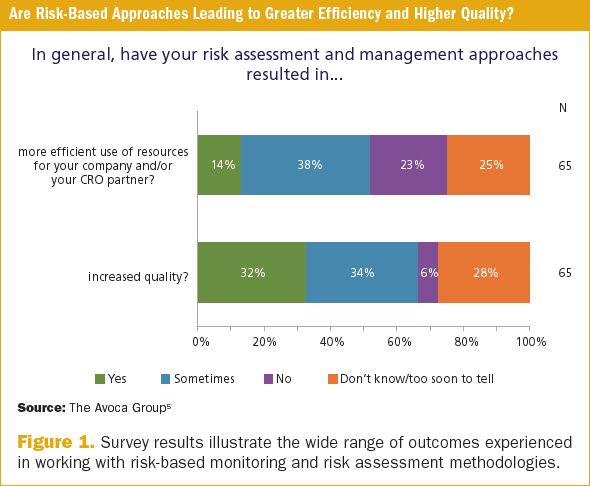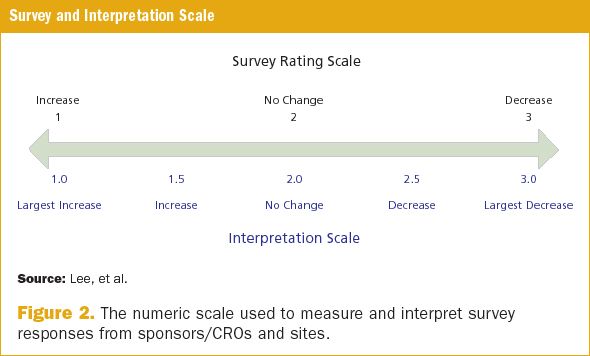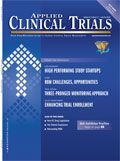Shifting Monitoring Paradigms: Challenges and Opportunities
Sponsor-site alignment on risk-based approaches is critical if clinical trial standards are to reach new levels.

Arguably as early as 2011 at a Clinical Trial Transformation Initiative (CTTI) meeting1, a joint academia, patient, sponsor, and regulators initiative focused on identifying and promoting practices that will increase the quality and efficiency of clinical trials, risk-based monitoring (RBM) as part of quality by design (QbD) concepts has been a popular topic of discussion within the pharmaceutical/biotech industry. More recently, RBM has come into significant focus with support by a reflection paper and guidance document issued by the European Medicines Agency (EMA)2, and the U.S. Food and Drug Administration (FDA)3, respectively, as well as industry groups such as TransCelerate BioPharma Inc., which published a broad description of RBM methodologies last year.4
The Avoca Group reported the industry's RBM experience and perceptions from its 2013 survey during last year's Drug Information Association (DIA) annual meeting.5 The results showed that:
- 34% of sponsor companies applied RBM to greater than 50% of outsourced clinical trials
- 33% of sponsor companies applied RBM to 1% to 50% of outsourced clinical trials
- 33% of sponsor companies never applied RBM to outsourced clinical trials
Thus, it is fair to state that RBM is gaining momentum within industry and with regulators. In spite of the intense interest, industry has yet to coalesce around a standard RBM methodology, and one could argue, never will. Despite the number of companies piloting their own RBM programs, as an industry, we continue to overlook a basic tenet of change management, which is to communicate the vision to our stakeholders, which should include clinical site professionals. It has been the lack of communication and transparency with clinical sites about RBM that has engendered misconceptions and disenfranchisement by clinical site staff.
Current state of affairs
TransCelerate BioPharma, launched in September 2012, is a non-profit organization comprised of pharmaceutical and biotechnology companies collaborating to create transformational process improvements that will help ensure safe and effective therapies are brought to market more efficiently. Following the publication of TransCelerate's Risk-Based Monitoring Methodology paper, it has been widely reported that its member companies are in various stages of implementing pilot programs using some or all of the methodologies as outlined in their joint paper. In addition, numerous other pharmaceutical and biotechnology companies have also publicly stated they have initiated pilot RBM programs, although no methodological details have been provided.
The Avoca Group, a consulting firm specializing in alliance and relationship management for pharmaceutical and biotechnology companies and contract research organizations (CROs), shared its industry survey results, which support the reality that RBM as part of risk assessment and management approaches is still in its infancy, with 34%-38% of the respondents relaying that their pilots "sometimes" led to more efficient use of resources or increased quality; whereas, 25%-28% relayed "don't know" or "too soon to tell." (See Figure 1).

The survey results underscore the opinion that companies perceive a wide range of outcomes in working with RBM and risk assessment methodologies for outsourced clinical trials and have yet to fully realize the anticipated benefits of increased efficiency and quality.
In a complementary survey from November 2013, Linking Leaders (http://linkingleaders.com/), an industry organization that provides a forum for clinical operations, quality, and outsourcing leaders to exchange insights around common challenges, distributed a survey to query sponsor and CRO representatives regarding the terminology they use to describe their RBM efforts, progress made in implementing RBM, and their perceptions of the impacts of RBM on clinical sites. More than 50% of the respondents characterize their efforts as "risk-based" monitoring. However, the others characterize their efforts as adaptive, data-driven, targeted, remote, or modeled monitoring or risk-based auditing. Interestingly, some respondents noted their aversion to characterizing their efforts as "risk based," as they feel it detracts from their intentions.

What is emerging is a picture of numerous companies utilizing various monitoring methodologies, using different terminology characterizing their efforts, and achieving varying degrees of success.
Perception is reality
In October 2013, the Society for Clinical Research Sites (SCRS) hosted its annual Site Solutions Summit, attended almost exclusively by investigators and site leaders. SCRS is a global trade organization representing 1,300 sites in 22 countries. The mission of SCRS (http://myscrs.org/) is to unify and amplify the voice of the global clinical research site community for site sustainability. The Linking Leaders Risk-Based Monitoring Committee was invited to present on RBM and engage in a discussion on its impact on sites.
In the months leading up to the Site Solutions Summit, Linking Leaders, together with SCRS, co-sponsored a RBM survey, assessing the sites' perceptions of the practice. The survey results were presented by the panelists, and further discussion and feedback were solicited. The questionnaire provided a global, broad cross-section of site professionals the opportunity to relay their experience, perspective, and understanding of RBM approaches. Survey respondents consisted of site leaders and investigators, largely from North America, with small contributions from the rest of the world. Preceding the summit, a joint Linking Leaders and SCRS article was published in the SCRS quarterly journal, InSite, outlining the basic tenets of RBM as well as some of the strategies employed to begin the dialogue.
Discussion surrounding the site survey responses during the summit elicited strong feedback regarding the significant impact of RBM on site workload with no regard for commensurate budget adjustments. To gain a sense of the pervasiveness of these sentiments, more than 50% of the attendees relayed that they are currently or had formerly participated in a study that utilized RBM methodologies. Surprisingly, the same proportion of site professionals in attendance expressed concern regarding the time and cost implications of faxing redacted source documents to central monitoring locations, periodically repeating this activity multiple times resulting from multiple requests by sponsors for the same source documents.
This highlighted the confusion around what some refer to as "RBM" versus "remote monitoring activities" resulting from sponsors taking a variety of RBM approaches, as well as the state of RBM today, which contributes to the lack of standardization of RBM models and approaches by sponsors. Also, there is a range of levels of adoption and strategies employed for RBM methodologies in the industry that is impacting sites conducting multiple clinical trials for multiple sponsors.
In addition, a common perception by many site staff is that sponsors are moving to RBM models to save significant amounts of money, and that the work is or will be pushed to clinical site staff without commensurate compensation for the additional resources for the additional work. It was clear that attendees at the Site Solutions Summit underappreciated the numerous data review and programmatic data monitoring activities that are typically put into place at the sponsor to enhance patient safety and allow for potentially less on-site monitoring, based on the site's performance.
Houston...we have a problem
The Linking Leaders industry survey demonstrated that sponsor perceptions regarding the impact of RBM on clinical sites are in sharp contrast to the perceptions held by sites. SCRS and Linking Leaders measured the same categories in the same manner using a numeric scale to allow for comparison. Figure 2 illustrates the numeric scale from 1 (increase) to 3 (decrease), with 2 representing no change. The scale used when interpreting the data is structured similarly, with 1.0 representing the largest increase and, conversely, 3.0 representing the largest decrease.

Table 1 compares responses to questions by site and industry professionals side-by-side to show these differences. To aid in the identification of the largest gaps in perception of a specific category, Linking Leaders and SCRS calculated the "difference from mode," which is difference from the numeric value of 2.

Although sponsors and site professionals agree that regulatory obligations are likely to increase slightly, there is little else that sponsors and sites have in common regarding their perceptions of the impacts of RBM on clinical sites:
- Sites expect the largest increases to be workload, while sponsors expect workload to decrease slightly
- Sites expect no change to data quality, while sponsors expect data quality to have the largest increase
- Sites expect an increase in resource needs, while sponsors expect resource needs to increase only slightly
- Sites expect budget increases that sponsors expect will not change
- Sites expect slight decreases in study volunteer safety and sponsors expect it to increase
Conclusions and future directions
The drug development industry depends on investigative sites to execute clinical trials, provide clinical data, and protect the safety and welfare of human trial subjects. As a critical stakeholder in the clinical development process, investigative sites should be an integral part of the industry conversation around the development of RBM models as sponsors begin to formalize potential approaches. Without a seat at the table and due to an insufficient focus on socializing RBM with the clinical site community, many sites misunderstand how RBM is defined and what it is intended to accomplish. Sites also perceive that RBM methodologies will lead to an increased burden on clinical site personnel without commensurate budget payments to support the added work. These impressions are magnified by their perception that there has been little regard by the industry for the potential impact of changes to monitoring approaches on the workload at the site or for modifications to operational activities performed by the sites.
The Linking Leaders Risk-Based Monitoring Committee asserts that the industry has not fully appreciated the impact of changing monitoring schemes on the site community. There is a need for raised awareness regarding the importance of pharmaceutical and biotechnology companies partnering with clinical site representatives, consortia, and site advocacy groups when developing RBM models. The discussions should include considerations of the impact the monitoring approach may have on items such as workload, timeliness of data entry, and budget consideration for the site, prior to or at the time the site is under consideration for participation in a new trial.
Industry and regulators have been making steady progress towards defining RBM, understanding the implications to current processes and systems, and defining approaches for implementation. It is recognized that the sites have not been involved in this dialogue while the industry sorts out its internal shifts in culture, systems, and processes. Sponsors have initially taken a seemingly myopic view of defining and understanding the new paradigm and have not realized or considered the full impact to clinical sites.
Sites, however, have also missed potential opportunities for proactive dialogue and participation in defining and implementing this change. Several avenues, such as investigator meetings, direct conversations with the sponsors, industry and site joint forums, and publications, as well as a currently established site advocacy group (SAG) by SCRS exist for proactive and constructive dialogue between sites and sponsors. TransCelerate BioPharma has made a commitment to work with SCRS through an RBM SAG in an effort to ensure the site's voice is considered. Working with sponsors, sites can take this opportunity to be proactive partners in this change.
The recognition by both sponsors and sites that the success of RBM is shared—the resulting cultural change impacting them equally—will drive the standards of clinical trials to a new level of quality, safety, and potentially become the model for collaborative innovation and problem-solving.
— This piece was a collaborative effort between Linking Leaders and the Society for Clinical Research Sites (SCRS), www.myscrs.org/.
Jonathan Lee is Vice President, Development Operations, Cerexa; Arti Bajpai is President, CQI Consulting, Compliance and Quality Integration; Elspeth Carnan, PhD, is Executive Director, R&D Operational Efficiency, Innovation and Process Improvement, Amgen; Karen A. Clarke is Director, Quality Assurance, Pfizer Medical, QA Disease Area Lead - Infectious Diseases, Pfizer Inc.; Sina Djali is Senior Director, Quality Monitoring and Compliance, Johnson & Johnson; Nadene Hausmann is Director, R&D Compliance Auditing, Biogen Idec; Janis Little is Vice President, Global Regulatory Quality, Allergan; David Myl is Head, Clinical Monitoring, Regeneron; Christine Pierre is Founder and President, Society for Clinical Research Sites; Ann Wang is an Independent Consultant.
References
1. Workshop on Quality Risk Management: Making Clinical Trials Fit for Purpose, August 23-24, 2011, Bethesda, MD, http://ctti-clinicaltrials.org/what-we-do/investigational-plan/qbd-qrm/meetings/workshop-1.
2. EMA Reflection Paper on Risk-Based Quality Management in Clinical Trials, August 4, 2011, http://www.ema.europa.eu/docs/en_GB/document_library/Scientific_guideline/2011/08/WC500110059.pdf.
3. FDA Guidance for Industry: A Risk-Based Approach to Monitoring, August 2013, http://www.fda.gov/downloads/Drugs/.../Guidances/UCM269919.pdf.
4. TransCelerate BioPharma Inc. Position Paper: Risk-Based Monitoring Methodology, May 30, 2013, http://www.transceleratebiopharmainc.com/wp-content/uploads/2013/09/Risk-Based-Monitoring-Methodology-Position-Paper.pdf.
5. The Avoca Group, The State of Clinical Outsourcing: Managed Risk in Outsourced Clinical Trials, DIA Annual Meeting, June 24, 2013, http://www2.theavocagroup.com/knowledge-center/presentations/managing-risk-in-outsourced-clinical-trials.

Improving Relationships and Diversifying the Site Selection Process
April 17th 2025In this episode of the Applied Clinical Trials Podcast, Liz Beatty, co-founder and chief strategy officer, Inato, discusses a number of topics around site engagement including community-based sites, the role of technology in improving site/sponsor relationships, how increased operational costs are impacting the industry, and more.
SCOPE Summit 2025: Enhancing the Patient Experience Through Site Centricity
February 12th 2025In an interview with ACT senior editor Andy Studna at SCOPE Summit, Ashley Davidson, vice president, product lead - sponsor tech strategy, Advarra, highlights the need for more site-centric approaches in study startup.